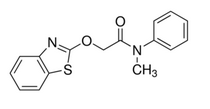MEFENACET 苯噻酰草胺, 苯噻草胺
Introduction: Mefenacet is a herbicide used for pre- and early post-emergence control of weeds including annual gramineae weeds and leptochloa chinensis, eleocharis acicularis, wartwort, monochoria vaginalis, rotala indica and perennial aquatic cyperus rotundus mainly in rice crops.
Common name: Mefenacet
Another name: rancho, Hinochaloa, Mefenacet [BSI:ISO], etc.
Chemical name: 2-(2-benzothiazolyloxy)-N-methyl-N-phenylacetamide
Empirical formula: C16H14N2O2S
Structural formula:

Mol. Weight: 298.36 g/mol
CAS No.: 73250-68-7
Specifications
Leading Mefenacet supplier
Mefenacet 50% WP
Mefenacet 95% TC
Packing:
BULK PACKING
Solid: 25kg/Bag, 25kg/Drum, 50kg/Drum etc.
SMALL PACKING
Solid: 1kg/Alu bag, 500g/Alu bag, 200g/Alu bag, 100g/Alu bag, 50g/Alu bag, 15g/Alu bag etc.
Customerized packing label
Professional registration
HAZARDS IDENTIFICATION
Hazard statement(s)
H361: Suspected of damaging fertility or the unborn child.
H373: Causes damage to organs through prolonged or repeated exposure.
H400: Very toxic to aquatic life.
H410: Very toxic to aquatic life with long lasting effects.
Precautionary statement(s)
P201: Obtain special instructions before use.
P202: Do not handle until all safety precautions have been read and understood.
P260: Do not breathe dust/fume/gas/mist/vapors/spray.
P273: Avoid release to the environment.
P281: Use personal protective equipment as required.
P308+P313: IF exposed or concerned: Get medical advice/attention.
P314: Get medical advice/attention if you feel unwell.
P391: Collect spillage.
P405: Store locked up.
P501: Dispose of contents/container to ...
Supplemental Hazard Statements: none
MAMMALIAN TOXICOLOGY
Acute toxicity: 1) Acute oral LD50 for rat: >5000 a.i.mg/kg. 2) Acute dermal LD50 for rat: >5000 a.i.mg/kg. 3) Inhalation LC50 (4 h) for rat: 0.02 a.i.mg/L. 4) Skin irritant (rabbits). 5) Irritant to eyes (rabbits). 6) A skin sensitiser (guinea pigs).
No component of this product present at levels greater than or equal to 0.1% is identified as probable, possible or confirmed human carcinogen by IARC.
ADI: 0.0036 mg/kg b.w.
Classification:
Toxicity class WHO (a.i.): U (Unlikely to present an acute hazard)
US EPA Classification (formulation):IV (Caution - Not acutely toxic)
EC Risk Classification: N - Dangerous for the environment: R51, R53
ECOTOXICOLOGY
Effect on birds: low toxicity to birds, acute LD50 for Bobwhite quail is 5000 a.i.mg/kg. Effect on fish: moderate toxicity to fish, acute 96 hour LC50 for Salmonidae is 6 a.i.mg/L. Effect on aquatic invertebrates: moderate toxicity to aquatic invertebrates, acute 48 hour EC50 for Daphnia magna is 1.81 a.i.mg/L. Effect on algae: moderate toxicity to algae, acute 72 hour EC50 for Scenedemus subspicatus is 0.18 a.i.mg/L. Effect on earthworms: moderate toxicity to earthworms, acute 14 day LC50 for Eisenia foetida is 1000 a.i.mg/kg.
ENVIRONMENTAL FATE
Mefenacet's production may result in its release to the environment through various waste streams; its use as a herbicide will result in its direct release to the environment. If released to air, an estimated vapor pressure of 6.4×10-4 mPa at 25 deg C indicates Mefenacet is low volatility. If released to soil, Mefenacet is expected to have Slightly mobility based upon an estimated Koc of 2964. Volatilization from moist soil surfaces is not expected to be an important fate process based upon an estimated Henry's Law constant of 4.77×10-5 Pa m3/mol. Biodegradation half-lives of 35 days using aerobic soils suggest that Mefenacet is Moderately persistent in soil. If released into water, Mefenacet is expected to adsorb to suspended solids and sediment based upon the estimated Koc. Volatilization from water surfaces is not expected to be an important fate process based upon this compound's estimated Henry's Law constant. An estimated BCF of 29 suggests the potential for bioconcentration in aquatic organisms is low. Mefenacet hydrolysis is stable at pH 4 to pH 9.
Usage: Selective, inhibits cell division and growth. Inhibition of VLCFA (inhibition of cell division).
Application: Selective systemic herbicide, inhibitor of cell growth and division. Absorbed by colephyllum and root, accumulating at the growth point to stop weeds’ growth. Control of annual weeds on transplanting rice field in cold area: 450~600g a.i./ha. In tropical and subtropical area: 375~450g a.i./ha. Specific dosage depends on different situation.
| 






